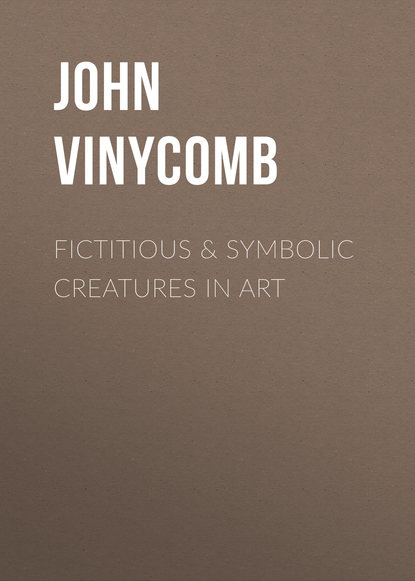 Полная версия
Полная версияFictitious & Symbolic Creatures in Art
“The external forms of Dragons are greatly dependent on the nature of the country in which they originate. In the far north, where exist the legends of the swan and pigeon, maidens and vampires, exists the swan-shaped dragon. As demons of excessive heat principally existed in the south, so in the north the great enemy of man was excessive cold. In the northern countries is found also the serpent element, but as serpents are there frequently harmless, this feature does not enter much into their composition. The Cuttlefish is supposed to have helped in the formation of the Hydra, which in its turn assisted in forming the dragon of the Apocalypse. Assyrian ideas also seem to have assisted in the pictorial impersonations of the hydra. This many-headed monster is a representation of a torrent, which being cut off in one direction breaks out in another. The conflicts of Hercules with the hydra are repeated in those of the Assyrian Bel with Trinant (the deep), and also in the contentions of St. Michael with the dragon. The old dragon myths left in Europe were frequently utilised by the Christians. Other saints besides St. Michael were invested with the feats of Hercules; St. Margaret, St. Andrew, and many others are pictured as trampling dragons under their feet. The Egyptian dragon is based on the crocodile, and this form being received into Christian symbolism did greatly away with other pagan monsters. The hideousness of the crocodile and the alligator could easily be exaggerated so as to suit the most horrible contortions of the human imagination. Amongst the most terrible dragons is Typhon, the impersonation of all the terrors of nature. Son of Tartarus, father of the harpies and of the winds, he lives in the African deserts; from thence fled in fear, to escape his terrible breath, all the gods and goddesses. He is coiled in the whirlwind, and his many heads are symbolical of the tempest, the scrive, the hurricane, and the tornado.”
Under the head of The Colonial Dragon Mr. Conway has embodied all the horrors and difficulties with which the early colonists would be beset. Amongst these he places the Gorgon and the Chimera. The most widely spread of all is the last named, and from it is supposed that all Christian and British dragons are descended. The Christian myth of St. George and the Dragon is but a variation of Bellerophon and the Chimera, in which the last has given place to the dragon and the pagan hero to St. George.
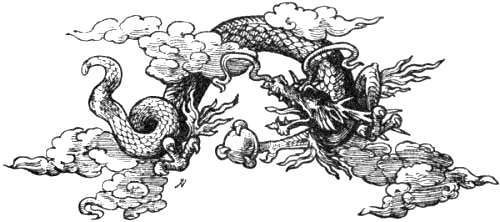
Japanese Dragon.
“In ancient families there are usually traditions of some far-distant ancestor having slain a desperate monster. It is always the colonial dragon that has been borrowed by poets and romancers. The Dragon killed by Guy of Warwick is but another variation of the chimera. There is again the Sockburn Worm, slain by Sir John Conyers for the devouring of the people of the neighbourhood; the well-known tradition of the Lambton Worm is in reality a modification of the Aryan Dragon of the Stormcloud; smaller than a man’s hand he swells out to prodigious dimensions.”
A favourite subject for Chinese and Japanese painting and sculpture is a dragon very much of the same type, and a monstrous representation of a dragon in the form of a huge Saurian still forms the central object at Japanese festivals.
Among the Chinese the dragon is the representation of sovereignty, and is the imperial emblem borne upon banners, and otherwise displayed as the national ensign. To the people of that vast country it represents everything powerful and imposing; and it plays an important part in many religious ceremonies and observances. Dr. S. Wells Williams, the eminent sinalogue, describes the fabulous monster of Chinese imagination in the following passage: “There are three dragons—the lung in the sky, the li in the sea, and the kiau in the marshes. The first is the only authentic species according to the Chinese; it has the head of a camel, the horns of a deer, eyes of a rabbit, ears of a cow, neck of a snake, belly of a frog, scales of a carp, claws of a hawk, and palm of a tiger. On each side of the mouth are whiskers, and its beard contains a bright pearl; the breath is sometimes changed into water and sometimes into fire, and its voice is like the jingling of copper pans. The dragon of the sea occasionally ascends to heaven in waterspouts, and is the ruler of all oceanic phenomena.” The fishermen and sailors before venturing away from land or returning to port, burn joss-sticks and beat gongs to ward off the evil influences of the dragon, and it is worshipped in a variety of ways. According to a fable current in China, the Celestial Emperor Hoang-ti was carried up to heaven, along with seventy other persons, by a great dragon; those who were only able to catch at his moustaches were shaken off and thrown on the ground. It is still the custom when an emperor dies to say that the dragon has ascended to heaven. An eclipse the simple Celestials believe to be caused by a great dragon that seeks to devour the sun or moon. A great noise is made by firing guns, beating drums, and the rattling and jangling of pairs of discordant instruments to frighten the monster away. A frequent subject of their artists is the dreadful dragon sprawling through masses of curling clouds in the act of grasping at or swallowing the great luminary, a subject which no doubt bears a deeper meaning than we see, and one intimately connected with their mythology.
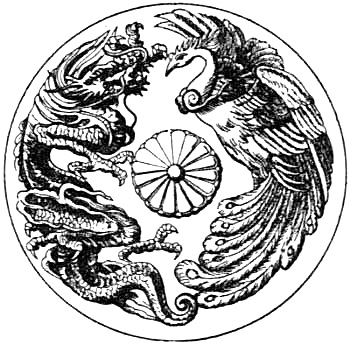
Japanese Imperial Device.
The Dragon, the Ho-Ho, or Phœnix, and the Chrysanthemum.
In some of their splendid festivals the worship of the dragon is celebrated with great excitement and furore. On the Canton river a boat of immense length formed like a dragon in many wondrous folds, rowed by fifty or more natives, with wild music and dancing, and accompanied by a crowd of junks; the unfurling of sails and the streaming of flags from the masts, the beating of drums, the noise and smoke from the firing of guns, all exhibit the fondness of a people for the pleasures of a national holiday.
Dragon’s Teeth.—Cadmus slew the dragon that guarded the well of Ares, and sowed some of the teeth, from which sprang up the armed men who all killed each other except five, who were the ancestors of the Thebans. Those teeth which Cadmus did not sow, came to the possession of Ætes, King of Colchis; and one of the tasks he enjoined on Jason was to sow these teeth and slay the armed warriors that rose therefrom. The frequent allusion to the classic term dragon’s teeth refers to subjects of civil strife; whatever rouses citizens to rise in arms.
The mythical dragon has left the lasting impress of his name in various ways in our language and literature, as in the art of nearly every country.
Ω Dragon’s Head and ℧ Dragon’s Tail.—In astronomy Nodes are the opposite points in which the orbit of a planet, or of a moon, crosses the ecliptic. The ascending node marked by the character (Ω), termed the Dragon’s head, is where the planet or moon ascends from the south to the north side of the ecliptic, and the descending node indicated by the character (℧) the Dragon’s tail is where it passes from the north to the south side.
Draco, a constellation in the northern hemisphere, representing the monster that watched the golden apples in the garden of the Hesperides, slain by Hercules, and set as a constellation in the heavens.
Draco volens, a meteor sometimes visible in marshy countries—Ignus fatuus, or will-o’-the-wisp.
Draco volens, or flying dragon, a curious class of saurian reptiles peculiar to the East Indies, having membranous attachments to their limbs, which give them the appearance of flying as they leap from tree to tree.
Dragon’s blood, a vegetable balsam of a dark red colour brought from India, Africa, and South America. So called from its resemblance to dried and hardened masses of blood.
The Dragon in Christian Art
It was believed that in the gloomy land of the Cimmerians and the confines of Hades strange monsters were to be met; and not only there, but in any part of the universe which was conceived to be beyond the pale of human habitation these weird creatures might be encountered. The same idea is recognised in the Semitic belief, that uncanny beings lurked in the outer deserts, where men did not penetrate at all, or did so only at great danger. The “place of dragons” is associated with “the shadow of death” (Ps. xliv. 19). Dragons are also associated with the waters of the deep (Ps. lxxiv. 13) and are called upon to praise Jehovah (Ps. cxlviii. 7); and Isaiah (xxxiv.), describing in vivid and picturesque language the destruction and utter desolation which shall come on Zion’s enemies, prophesies that her palaces and fortresses “shall be a habitation for dragons.”
The term dragon is applied by the translators of the Scriptures to some monsters of which we have no knowledge. The word is used by ecclesiastics of the Middle Ages as the symbol of sin in general and paganism in particular, though ofttimes heresy is denoted. The metaphor is derived from Rev. xii. 9, where Satan is termed the Great Dragon; in Psalm xci. 13, it is said “the saints shall trample the dragon under their feet.”
In the book of Job we recognise in Leviathan a creature more like the extinct saurians of the old world than any crocodile recorded in historic times; and this leviathan is treated as still existing in the days of David. In Psalm lxxiv. 13, 14, Jehovah is spoken of as having broken the heads of the dragons in the waters; in Isaiah li. 9, as having wounded the dragon; and pæans are sung on the punishment of “Leviathan, that crooked serpent,” and the slaying of “the dragon that is in the sea” (Is. xxvii. 1). Finally, in the Apocalyptic vision, “there appeared another wonder in heaven; and behold a great red dragon, having seven heads, and ten horns, and seven crowns upon his heads, and his tail drew the third part of the stars of heaven, and did cast them to earth” (Rev. xii. 3, 4); “I saw an angel come down from heaven, having the key of the bottomless pit and a great chain in his hand, and he laid hold on the dragon, that old serpent, which is the Devil and Satan, and bound him” (Rev. xx. 1, 2).
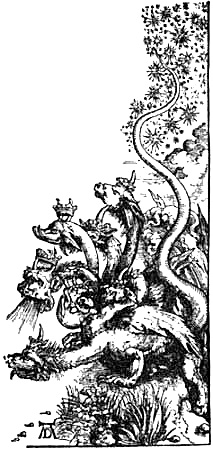
The Dragon of the Apocalypse.
By Albert Dürer.
As a Christian emblem the dragon may be taken to symbolise the supreme spirit of evil, a veritable devil whom it was the special mission of militant saints to slay, as it had been the glory of the heroes of the pagan mythology to conquer. “In pictures of sacred and legendary subjects,” says a late writer, “the dragon usually formed an important feature. The evil thing was invariably depicted writhing under the foot of the saint, or transfixed with his triumphant spear. In like manner the virtues trampled tranquilly each on her complementary vice, embodied in the form of some impossible creature; and if the rigid virtues were sometimes insipid, it must be allowed that the demons were usually grotesquely characteristic, and often delightful in colour.”
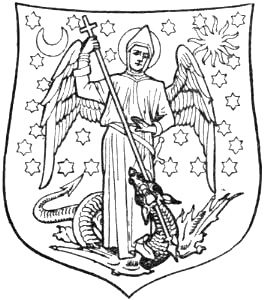
St. Michael and the Old Dragon.
Arms of the Royal Burgh of Dumfries.
The prostrate attitude usually signifies the triumph of Christianity over Paganism, as in pictures of St. George and St. Sylvester; or over heresy and schism, as when it was adopted as the emblem of the Knights of the Order of the Dragon, in Hungary, which was instituted for the purpose of contending against the adherents of John Huss and Jerome of Prague.
The dragon in Christian Art is often very variously represented, sometimes as a serpent, at other times as a dragon or wyvern, or again in the symbolic figure partly human, under which form we find the “old serpent” (the Devil) often represented, as in the conflict of St. Michael the Archangel. The numerous legends of saints who have fought and overcome dragons prove the symbolic light in which the impersonation of evil was generally viewed.
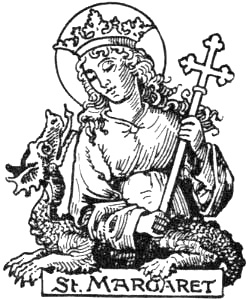
From ancient carving.
St. Margaret is the patron saint of the borough of Lynn Regis, and on the old corporation seal she is represented standing on a dragon and wounding it with a cross. The Latin inscription on the seal is “Sub Margaret teritur draco stat cruce læta.” The modern shield of the town is now blazoned: azure three conger’s (or dragon’s) heads erased and erect, the jaws of each pierced with a cross crosslet fitchée or. In paintings St. Margaret is represented as a young woman of great beauty bearing the martyr’s palm and olive crown, or with the dragon chained and helpless at her feet as an attribute. Sometimes she is depicted coming from the dragon’s mouth, for the legend says the monster swallowed her, but on her making the sign of the cross he was compelled to free her again. A legend states that Olybus, Governor of Antioch, captivated by the beauty of Margaret, wished to marry her; as she rejected him with scorn he threw her into a dungeon, where the devil appeared to her in the form of a horrible dragon and endeavoured to frighten her from her path. Margaret held up the cross and the dragon fled. Other legends say he burst asunder.
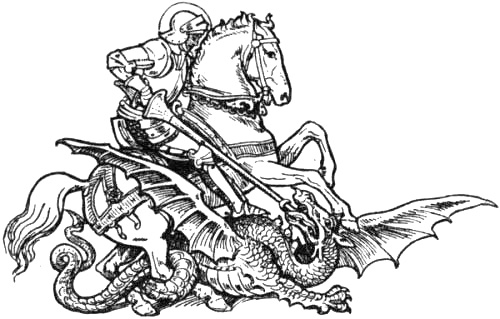
St. George and the Dragon.
“In many a church his form is seen,With sword, and shield, and helmet sheen:Ye know him by his steed of pride,And by the dragon at his side.”Chr. Schmid.
St. George, the patron saint of England, in his legendary combat with the monster, is a subject which occurs frequently in English sculpture and painting, and enters largely into the language and literature of the nation. St. George appears to have been selected as the patron saint of England not long after the Norman conquest. We find the anniversary of his martyrdom (April 23) was ordered to be observed as a festival by the National Synod of Oxford in 1222 a.d.
The “Golden Legend,” printed by Pynson in 1507 (fol. cxix.), thus refers to “Saynt George”: “This blyssed and holy martyr Saynt George is patrone of this realme of Englōd: and ye crye of mē of warre; and in ye worsyp of whome is founded ye noble order of a garter: and also ye noble college in ye castell of Wyndsore, by Kynges of Englond. In whyche college is ye herte of Saynt George: whyche Sygysmond ye Emperour of Alamayn brought: and gaf it for a grete and precyous relyque to kynge Harry the fifte. And also the said Sygysmond was broder of the sayd garter. And also there is a piece of his head; which college is nobly endowed to thonour and worshippe almighty God and his blyssed Martyr Saynt George. Then late us praye vnto hym that he be specyel protectour and defendour of this royaume.”
The emblems commonly given to St. George, martyr, and patron saint of England are: a dragon, a shield bearing a red cross on a white field, and a spear. He is usually represented on horseback in the act of spearing the monster which is vomiting fire; or as standing with the slain dragon at his feet.
That St. George is a veritable character is beyond all reasonable doubt, and there seems no reason to deny that he was born in Armorica, and was beheaded in Diocletian’s persecution by order of Datianus, April 23, 303. St. Jerome (331-420) mentions him in one of his martyrologies; in the next century there were many churches erected to his honour. St. Gregory (540-604) has in his sacramentary a “Preface for St. George’s Day”; and the Venerable Bede (672-735) in his martyrology, says: “At last St. George truly finished his martyrdom by decapitation, although the gests of his passion are numbered among the apocryphal writings.”
According to the old ballad given in Bishop Percy’s “Reliques of Ancient Poetry,” St. George was the son of Lord Albert of Coventry. His mother died in giving him birth, and the new-born babe was stolen away by the weird lady of the woods, who brought him up to deeds of arms. His body had three marks: a dragon on the breast, a garter round one of the legs, and a blood-red cross on the arm. When he grew to manhood he first fought against the Saracens, and then went to Sylene, a city of Libya, where was a stagnant lake infested by a huge dragon, whose poisonous breath “had many a city slain,” and whose hide “no spear nor sword could pierce.” Every day a virgin was sacrificed to it, and at length it came to the lot of Sabra, the king’s daughter, to become its victim. Decked out in bridal array she went out to meet the dragon; she was tied to the stake, and left to be devoured, when St. George appeared in full panoply and mounted on his charger. He vowed to take her cause in hand, and when the dragon came on the scene it was encountered by the hero, who wounded it, and binding it to the lady’s girdle it was led like a “meek beast” into the city. St. George there attacked it, thrusting his lance into its mouth, killed it on the spot, and a church dedicated to Our Lady and St. George was built to commemorate the event. After many adventures he carried off Sabra to England, where they were wedded, and at Coventry lived happily till their death.
In his history of the Order of the Garter Mr. Antis warmly censures those who would doubt the traditionary history of that saint, and says “he who would credit St. Ambrose will not detract from the honour of our George, the soldier and martyr of Christ, concerning the dragon and the deliverance of the beautiful royal virgin, which is related in so many pictures,” adding that “he shall not contradict those who make an allegory of it, so that they do not deny the certainty of this history.... Suppose every one George, who being clothed with the virtue of baptism and armour of faith, keeps his earthly body in subjection by the due exercise of religion and piety, and by the armour of the Spirit overcomes, and by the true spiritual art crushes and confounds the serpent’s poison, the snares of the old Dragon, and his diabolical arts and stratagems.”
The dragon slain by St. George is simply a common allegory to express the triumph of the Christian hero over evil, which St. John the Evangelist beheld under the figure of a dragon. Similarly St. Michael, St. Margaret, St. Sylvester and St. Martha are all depicted as slaying dragons; the Saviour and the Virgin as treading them under foot; and St. John the Evangelist as charming a winged dragon from a poisoned chalice given him to drink. Even John Bunyan avails himself of the same figure, when he makes Christian encounter Apollyon and prevail against him.
A learned Frenchman, M. Clermont Ganneau, in a treatise lately published, traces the legend of St. George and the dragon to a very remote antiquity. In the Louvre at Paris he found an Egyptian bas-relief, which he identified as the combat of Horus against Set, or Typhon, in the well-known Egyptian legend. It represents a man on horseback in Roman armour slaying a crocodile with a spear; but for the fact that the rider has a hawk’s head, the group might easily be mistaken for the traditional combat of St. George and the dragon. Extending his investigations, M. Ganneau has brought to light some most startling proofs of the connection between the eastern and western mythologies. We have therefore, he considers, evidence as clear and convincing as evidence from deduction can be, that the Egyptian “Horus and Typhon”; the Greek “Perseus and Andromeda”; the “Bel and Dragon” of the Apocrypha; the Archangel Michael of Christian legend who also slays the old dragon, are all one and the same story with that of our own St. George. We pass over the intermediate steps by which he reconciles the divergent names and qualities of the personages identified, and also the ingenious arguments as to the real meaning of the symbolism in the worship of Dagon the Fish-god.
In all the old romances dealing with feats of chivalry and knight-errantry the dragon plays an essential if not a leading part; and a romance without some dragon or monster was as rare as one without a valiant knight or a beautiful lady. But of all the malignant creatures dreaded of gods and men, the most hateful and wicked is that prime dragon personified by Spenser under the type of the “blatant beast,” and which confronts his hero, the Red Cross Knight, at every turn: “a dreadful fiend, of gods and men ydrad,” who has a thousand tongues, speaks things most shameful, most unrighteous, most untrue, and with his sting steeps them in poison.
As an example of the inception and development of a dragon legend from slender materials, the following is related in Figuer’s “World before the Deluge”:
In the city of Klagenfurth, in Carinthia, is a fountain on which is sculptured a monstrous dragon with six feet, and a head armed with a stout horn. According to popular tradition this dragon lived in a cave, whence it issued from time to time to ravage the country. A bold and venturous knight at last kills the monster, paying with his life the forfeit of his rashness. The head of the pretended dragon is preserved in the Hotel de Ville, and this head has furnished the sculptor for a model of the dragon on the fountain. A learned professor of Vienna on a visit to the city recognised it at a glance as the cranium of the fossil rhinoceros. Its discovery in some cave had probably originated the fable of the knight and the dragon—and all similar legends are capable of some such explanation when we trace them back to their sources and reason the circumstances on which they are founded. The famous bird, the roc, which played so important a part in the myths of the people of Asia, is also believed to have originated in the discovery of some gigantic bones.
Chief among Dragon-slayers of Christian legend we find the following:
St. Philip the Apostle is said to have destroyed a huge dragon at Hierapolis, in Phrygia.
St. Michael, St. George, St. Margaret, Pope Sylvester, St. Samson, Archbishop of Dol; Donatus (fourth century), St. Clement of Metz, all killed dragons—if we may trust old legends.
St. Keyne of Cornwall slew a dragon.
St. Florent killed a terrible dragon who haunted the Loire.
St. Cado, St. Maudet and St. Paull did similar feats in Brittany.
The town of Worms (famous as the place at which the Diet of Worms was held before which the reformer Luther was summoned) owes its name to the “Lind-wurm” or dragon there conquered by the hero Siegfried as related in the “Nibelungen Lied.” (See p. 100.)
Drachenfels, on the Rhine (Dragon Rocks), is so called from the same monster; and at Arles and Rouen legends are preserved of victories gained by saints over the Tarasque and Gargouille, both local names for the dragon. St. Martha conquered the fabulous Tarasque of the city of Languedoc, which bears the name of “Tarascon.” Gargouille (waterspout) was the great dragon that lived in the Seine, ravaged Rouen, and was slain by St. Romanus, Bishop of Rouen, in the seventh century. The latter name has come down to us in the term “gargoyle,” applied to the monstrous heads which often decorate the waterspouts of old churches.
A strange relic of the ancient faith is perpetuated in the remains of early Celtic art in the curiously wrought interlaced monsters which form the chief ornament of ancient Irish crosses, and particularly in the borders and initials of illuminated manuscripts, whose spirals and interminable interlacements of the most complex character, often allied with equally strange colouring, form a style perfectly unique in itself, and unlike any other; the elaborate knots terminating in draconic heads, and with wings and animal extremities in wonderfully ingenious patterns that seem almost beyond the limits of human ingenuity. In the kindred art of Scandinavia we find similar decoration founded on serpentine forms.
Another survival of the dragon myth exists in the name given to some of our fighting men on the introduction of firearms. A kind of blunderbus gave to the troops who used it the name of “dragoniers,” whence is derived the well-known term dragoons. They used to be armed with dragons—i.e., short muskets—which spouted fire, like the fabulous beast so named. The head of a dragon was wrought on the muzzles of these muskets. We have all heard of the Dragonades, a series of persecutions by Louis XIV., which drove many thousands of Protestants out of France—and out of the world. Their object was to root out “heresy.” A bishop, with certain ecclesiastics, was sent to see if the heretics would recant; if not they were left to the tender mercies of the Dragonniers, who followed these “ministers of peace and good will to men.” The same game of conversion was practised by the Reformed Church upon the Presbyterians of Scotland, with its accompaniment of “dragons let loose”—in which Claverhouse took a leading part.



